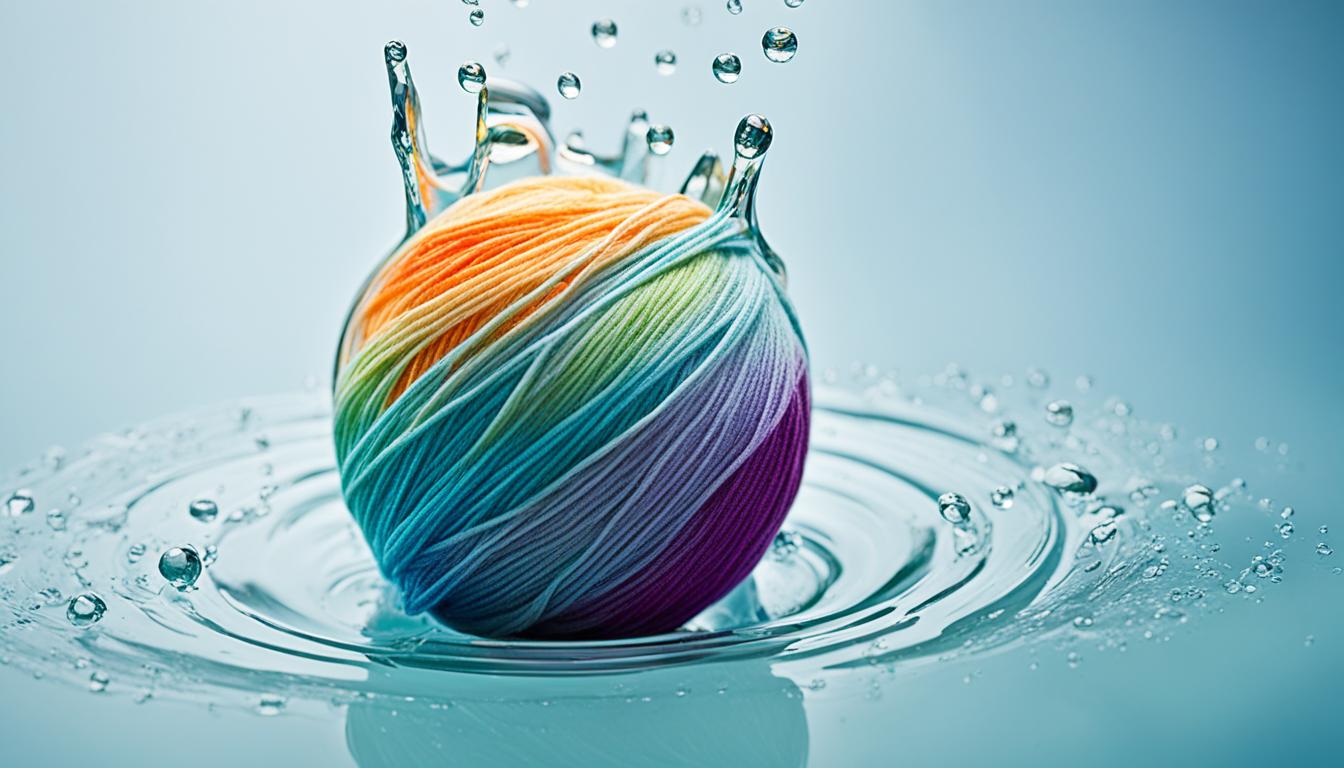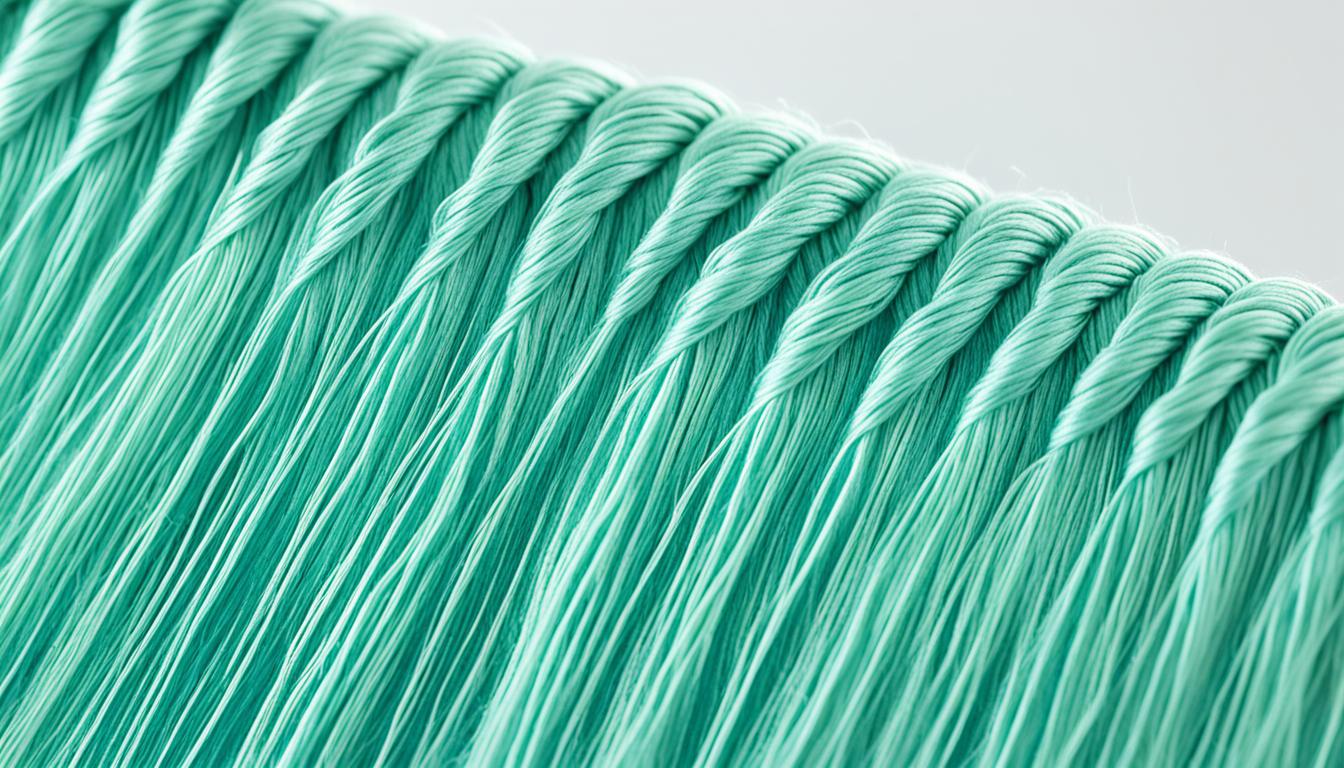When it comes to caring for our cherished yarn, a common question is often asked: Can yarn be submerged in water? We may have reservations, concerned that water could harm or destroy our valuable fibers. So, what’s the reality? Can yarn actually endure water, or is it preferable to keep it dry and protected?
In this article, we will explore the effects of water on yarn, understanding its absorbency, durability, and properties in water. We will also provide valuable tips and insights on how to properly care for different types of yarn, ensuring their longevity and preserving their quality. Let’s dive in!
Key Takeaways:
- Understanding how water affects yarn is crucial for proper care and maintenance.
- Different types of yarn have varying water resistance and absorbency properties.
- Following the care instructions on the yarn label is essential for optimal results.
- Wool, cotton, acrylic, and blends require specific care techniques to ensure their longevity.
- Proper storage and blocking techniques help maintain the shape and quality of knitted projects.
Washing Wool Yarn: A Practical Example
When it comes to caring for wool yarn, special attention is required to ensure its longevity. Most wool yarns recommend either dry cleaning or handwashing with soapflakes. Handwashing wool yarn is the preferred method as it allows for better control and care.
Here are some care instructions for washing wool yarn:
- Avoid soaking: Submerging wool yarn in water for an extended period can cause the fibers to stretch and lose their shape. Instead, gently agitate the yarn in a basin of lukewarm water mixed with a mild detergent.
- Wringing: Never wring or twist wool yarn to remove excess water, as it can lead to irreversible damage. Instead, press the yarn gently against the sides of the basin to squeeze out the water.
- Drying: Reshape the wet wool yarn and lay it flat on a clean towel or drying rack away from direct sunlight. This helps to preserve its shape and prevent any color fading. Drying wool yarn flat is essential, as hanging it can cause stretching and deformities.
- Excess water removal: To remove additional water from the yarn, you can either give it a short spin in the dryer on the lowest heat setting or roll it in a towel and press gently. Drying wool yarn properly helps prevent mildew and potential damage.
- Avoid ironing: High heat from irons can damage wool fibers, leading to irreversible changes in texture and appearance. It is advisable to avoid ironing wool yarn altogether.
Lastly, it’s important to note that wool yarn should be washed sparingly to preserve its natural oils, which contribute to its softness and luster. Excessive washing can strip away these oils, resulting in a less desirable texture and appearance.
Handwashing Wool Yarn: Best Practices
Remember to always follow the washing instructions provided on the yarn label. Each yarn may have specific care requirements that are crucial for maintaining its quality.
By taking proper care when washing wool yarn, you can ensure its longevity and keep your yarn projects looking their best. With gentle washing and proper handling, your wool yarn creations will stand the test of time.
See the table below for a summary of the essential wool yarn maintenance techniques:
| Step | Instructions |
|---|---|
| Avoid soaking | Gently agitate in lukewarm water mixed with mild detergent. |
| Wringing | Never wring or twist; press gently to remove excess water. |
| Drying | Reshape and lay flat to dry away from direct sunlight. |
| Excess water removal | Short spin in the dryer or roll in a towel to remove water. |
| Avoid ironing | High heat can damage wool fibers. |
Washing Cotton Yarn: Easy Care
When it comes to caring for your cotton yarn projects, you’ll be happy to know that cotton yarn is generally easy to care for. Most cotton yarn can be machine-washed, making it convenient and hassle-free to keep your projects clean and fresh.
However, it’s essential to keep in mind that unmercerized cotton yarn may shrink when washed. To prevent any unwanted surprises, we recommend washing a gauge swatch before immersing your entire project in water. This precautionary step will help you determine the final dimensions and ensure that your finished item fits as intended.
When it’s time to wash your cotton yarn, you can simply use the delicates setting on your washing machine. This gentle cycle will help protect the yarn and minimize any potential damage. For drying, we recommend using the delicates setting on your dryer or allowing your project to air dry flat.
With proper care, cotton yarn can maintain its durability and longevity, ensuring that your projects will stand the test of time. So go ahead and create beautiful cotton garments and accessories with confidence, knowing that maintaining them will be a breeze.
| Washing Instructions for Cotton Yarn: | Important Tips: |
|---|---|
| Machine wash on delicates setting | – Washing a gauge swatch before washing the entire project – Avoiding heat during drying |
| Air dry flat or use delicates setting on dryer | – Using a gentle laundry detergent – Avoiding bleach or harsh chemicals |
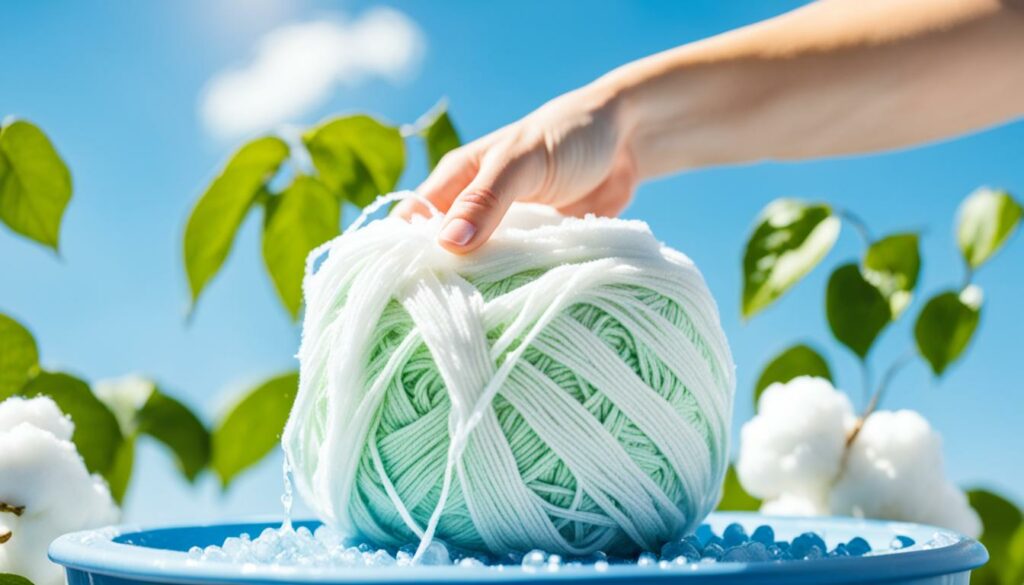
Linen and Hemp Yarn: Special Care for Plant Fibers
When it comes to caring for linen and hemp yarn, special attention is needed due to their unique plant-based nature. These natural fibers require gentle handling to maintain their quality and longevity. Let’s explore some essential tips for linen yarn care, hemp yarn care, and the proper care of plant-based fibers.
Washing Plant Fibers: Breaking Down Cellulose in Linen and Hemp Yarn
One of the crucial factors to consider when washing linen and hemp yarn is the delicate structure of cellulose present in the fibers. Rough washing techniques can break down the cellulose, resulting in a softer and more pleasant yarn. To preserve the integrity of these natural fibers, follow these steps:
- Fill a basin or sink with lukewarm water.
- Add a mild detergent specifically formulated for plant fibers.
- Gently agitate the water to create a soapy solution.
- Place the linen or hemp yarn in the water, ensuring it is fully submerged.
- Gently swirl and squeeze the yarn, avoiding any harsh rubbing or twisting that could damage the fibers.
- Allow the yarn to soak for about 10 minutes, ensuring the detergent penetrates and cleans the fibers.
- Drain the soapy water and rinse the yarn with fresh water until the water runs clear.
- Press out excess water gently, without wringing or twisting, to avoid misshaping the yarn.
Linen and Hemp Fabric Drying: Minimizing Wrinkling
Proper drying is an essential step in linen and hemp yarn care. To minimize wrinkling and preserve the natural shape of the fibers, follow these guidelines:
- Lay the yarn on a clean, dry towel in its natural shape.
- Roll the towel with the yarn inside to remove excess water.
- Unroll the towel and lay the yarn flat on a drying rack or another clean, dry towel.
- Avoid hanging the yarn to dry, as it may cause stretching or distortion.
- Ensure adequate air circulation to facilitate drying.
- Allow the yarn to air dry completely before handling or storing.
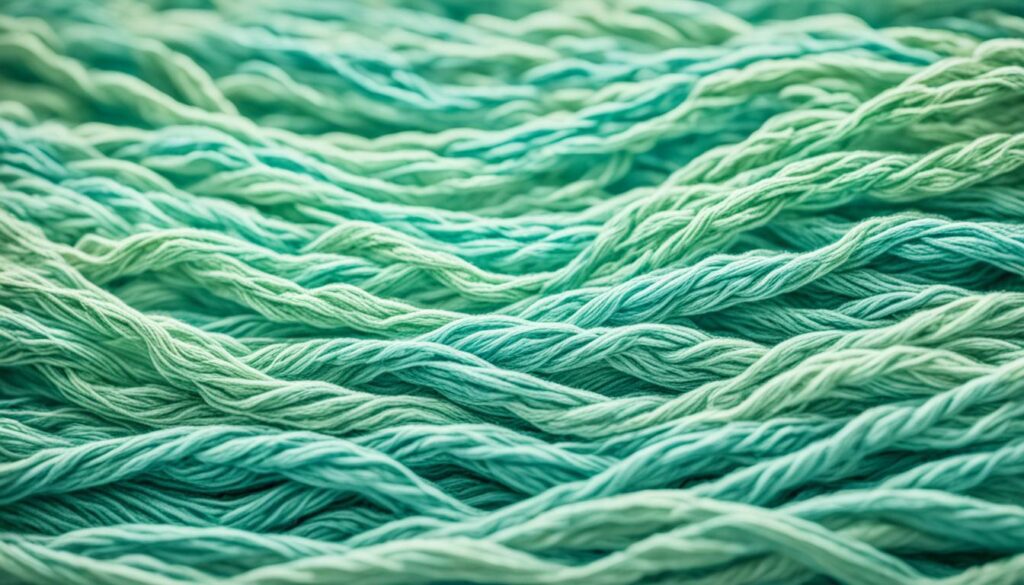
With these gentle washing and drying techniques, you can effectively care for your linen and hemp yarn, ensuring its longevity and maintaining its original beauty. By respecting the delicate nature of these plant fibers, you can create stunning projects that showcase the unique qualities of linen and hemp yarn.
Comparison of Linen and Hemp Yarn Care
| Linen Yarn Care | Hemp Yarn Care | |
|---|---|---|
| Washing | Gentle handwashing in lukewarm water with mild detergent | Gentle handwashing in lukewarm water with mild detergent |
| Drying | Lay flat to dry on a clean, dry towel or drying rack | Lay flat to dry on a clean, dry towel or drying rack |
| Wrinkling | Minimize wrinkling by handling with care and avoiding harsh rubbing or twisting | Minimize wrinkling by handling with care and avoiding harsh rubbing or twisting |
By following these care instructions, you can ensure that your linen and hemp yarn remains in excellent condition, ready for your next knitting or crochet project. Take the time to care for these plant fibers properly, and they will reward you with beautiful creations that showcase their unique qualities.
Acrylic Yarn: Easy Maintenance
Acrylic yarn is a popular choice among yarn enthusiasts for its durability and ease of care. Its synthetic composition makes it resistant to heat and agitation, allowing for hassle-free cleaning and maintenance.
When it comes to washing acrylic yarn, machine-washing is typically safe and convenient. Use a gentle cycle with cold or lukewarm water to prevent any potential stretching or damage. For added protection, consider placing the yarn in a mesh laundry bag to minimize tangling.
Drying acrylic yarn is equally simple. It can withstand high heat in the dryer without melting or warping, making it a time-saving option. However, keep in mind that excessive heat may cause the development of pills on the yarn surface.
To prevent acrylic yarn from melting, it is important to avoid ironing it. The high heat of an iron can cause the synthetic fibers to melt and lose their shape.
Here are some quick tips for acrylic yarn care:
- Machine-wash acrylic yarn on a gentle cycle with cold or lukewarm water.
- Dry acrylic yarn in the dryer on a low or medium heat setting. Avoid excessive heat to prevent pill development.
- Avoid ironing acrylic yarn to prevent melting.
| Pros of Acrylic Yarn Care | Cons of Acrylic Yarn Care |
|---|---|
| Resistant to heat and agitation | May develop pills with extended use |
| Can be machine-washed with cold or lukewarm water | Should not be ironed to prevent melting |
| Can withstand high heat in the dryer |
Overall, acrylic yarns offer a convenient and low-maintenance option for yarn enthusiasts. With proper care, they can retain their durability and vibrant colors, providing endless possibilities for creative projects.
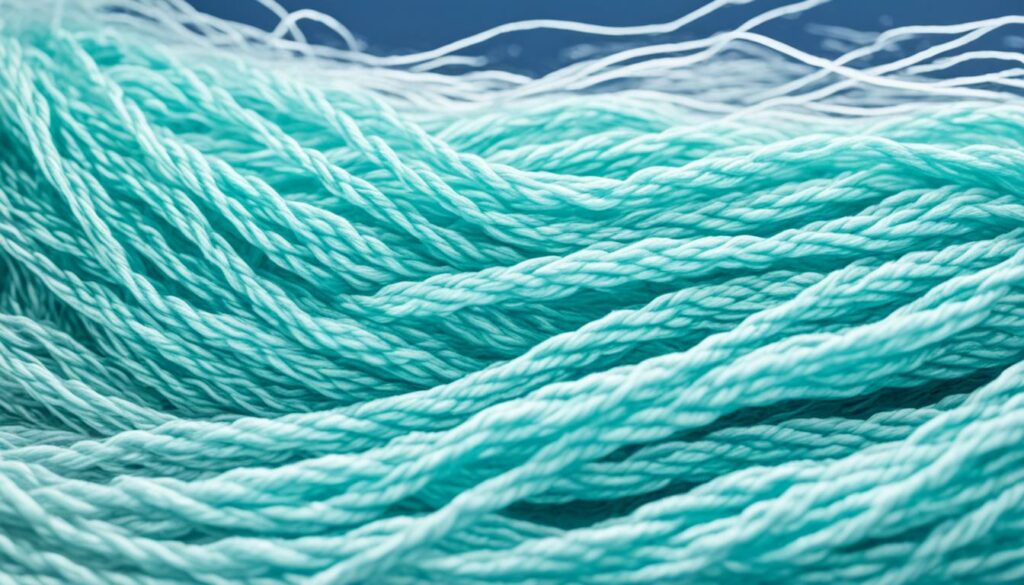
Superwash Yarns and Blends: Unique Properties
When it comes to caring for your yarn, superwash yarns and blends require special attention due to their unique properties. Superwash yarns have been treated to withstand machine-washing without felting, making them a convenient choice for those who prefer easy care options. However, it is important to note that while superwash yarns are designed to be machine-washable, it is still recommended to machine wash them on the delicate cycle to ensure their longevity and preserve their softness. After washing, be sure to lay the yarn flat to dry, as this will help maintain its shape and prevent stretching.
Blends, on the other hand, can have different care instructions depending on the dominant fiber in the yarn. It is crucial to check the label for specific care instructions and additional advice tailored to the particular blend you are working with. To determine the appropriate washing technique, we recommend knitting a test swatch and washing it according to the instructions. This will give you a clear idea of how the blend reacts to washing and help you avoid any potential issues such as shrinkage or felting.
Remember, taking proper care of your superwash yarns and blends will not only ensure their longevity but also help them maintain their softness and beautiful appearance. By following the recommended care instructions and treating your yarn with care, you can enjoy your creations for years to come.
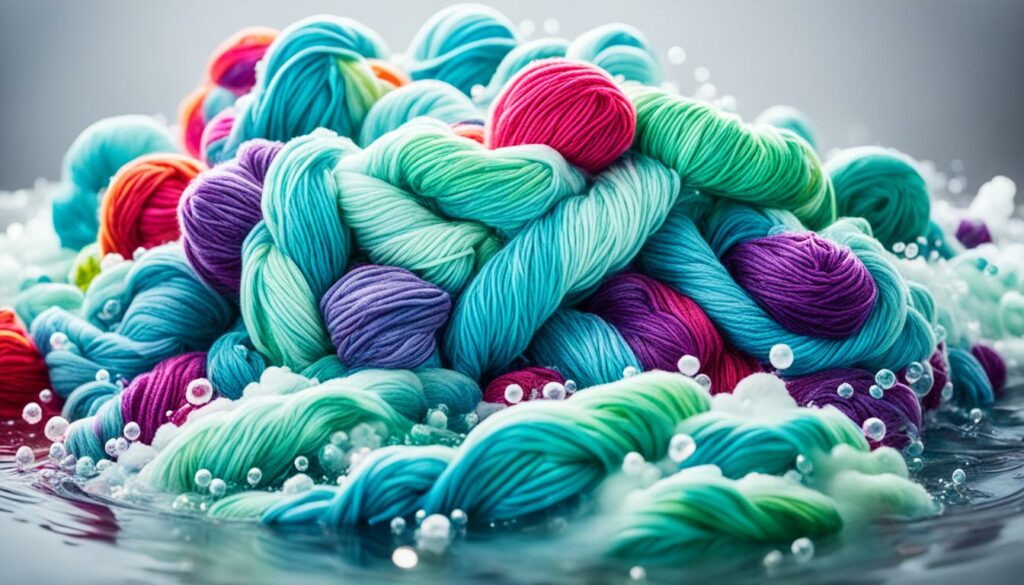
Wool’s Water Repellent Properties
Wool fibers possess remarkable water repellency, making them an ideal choice for various applications. The unique structure of wool enables it to repel liquid water on the surface while simultaneously attracting water vapor inside the fiber. Let’s explore the fascinating properties of wool that contribute to its ability to repel liquid water.
Water Behavior on Wool
When water comes into contact with wool, it behaves in a distinct manner. The outer layer of wool fiber, known as the epicuticle, acts as a natural water repellent. It prevents water from permeating the surface, effectively causing water droplets to bead up and roll off without saturating the fiber.
Furthermore, the interior of the wool fiber exhibits adsorption properties, attracting water molecules through hydrogen bonding. This unique combination of surface repellency and internal adsorption enables wool to maintain its structure and functionality even in damp conditions.
Wool’s complex structure allows it to repel liquid water on the surface while attracting water vapor inside the fiber, making it a versatile choice for all-weather performance.
Wool Fiber Properties
The water repellent properties of wool can be attributed to its inherent characteristics. The wool fiber structure consists of overlapping scales or cuticles, which contribute to its natural resistance to water penetration. These scales create a barrier that prevents water from seeping into the fiber, keeping the core of the wool dry.
In addition, wool fibers have a high degree of crimp, meaning they contain numerous bends and curves. This crimped structure creates air pockets within the fiber, enhancing its insulation properties and helping to maintain warmth even when exposed to moisture.
Applications of Wool’s Water Repellency
Wool’s ability to repel liquid water makes it well-suited for a range of applications. In outdoor gear and performance clothing, wool garments provide reliable protection against inclement weather conditions. Even when fully saturated, wool retains its insulating properties, keeping the wearer warm and comfortable.
Wool’s water repellency also extends to home textiles, such as upholstery and rugs. These woolen products maintain their aesthetics and functionality, even in areas prone to spills or high humidity.
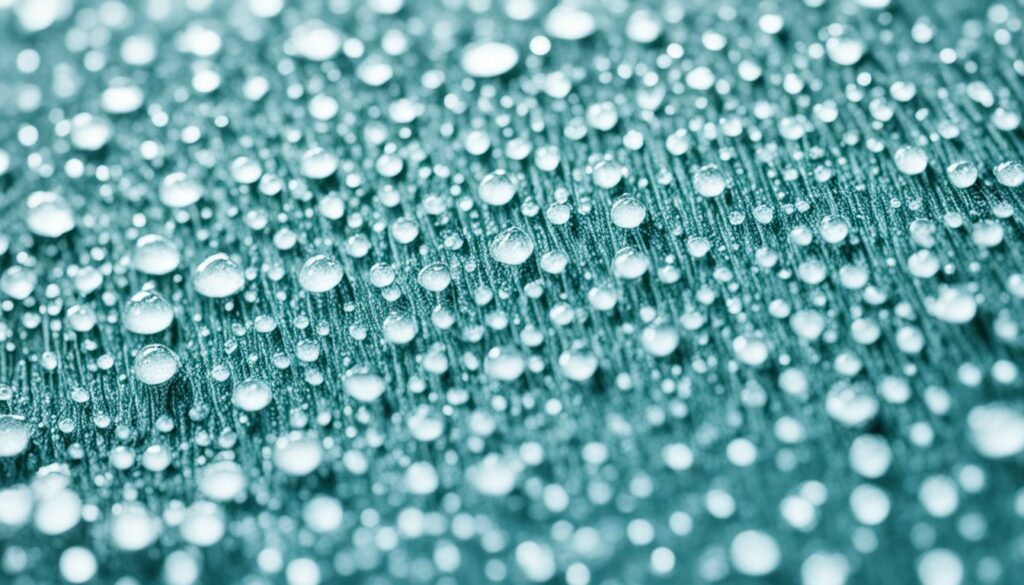
Real-Life Stories of Wool’s Water Resistance
In real-life outdoor adventures, wool has proven to be a remarkable natural fiber that excels in wet conditions. Its ability to withstand water and provide reliable performance has made it a top choice for outdoor enthusiasts worldwide.
When fully saturated with water, wool garments continue to provide excellent protection and insulation. Whether you’re hiking, camping, or engaging in water-based activities, wool’s unique properties ensure your comfort and safety.
“During a recent backpacking trip in the mountains, I experienced firsthand the incredible water resistance of wool. Despite heavy rainfall, my wool base layers remained warm and dry, keeping me comfortable throughout the journey. It was impressive to see how well wool performs even in the wettest conditions.”
Wool’s ability to retain heat even when wet is a game-changer for outdoor activities. Unlike synthetic fibers that lose their insulating properties when wet, wool naturally regulates body temperature and provides warmth, ensuring you stay comfortable and protected.
“As a professional outdoor guide, I always rely on wool garments to keep me comfortable during my adventures. Whether I’m hiking, kayaking, or camping, wool’s ability to withstand water is remarkable. Even after hours of exposure to rain and splashes, my wool garments never fail to keep me warm and dry.”
In addition to its water resistance, wool is also highly breathable, allowing moisture to escape and preventing you from feeling clammy or sweaty. This breathability ensures optimal comfort during strenuous activities, reducing the risk of overheating or discomfort.
Moreover, wool’s natural ability to resist water absorption makes it an excellent choice for extended outdoor trips. Its durability and performance in wet conditions make wool garments a reliable investment with long-lasting benefits.

The Benefits of Wool in Outdoor Activities
When participating in outdoor activities such as hiking, camping, or skiing, wool offers numerous advantages:
- Water resistance: Wool’s ability to repel water keeps you dry and protected in wet conditions.
- Insulation: Wool retains heat even when wet, ensuring warmth and comfort in cold environments.
- Breathability: Wool’s natural breathability allows moisture to escape, preventing sweat buildup and maintaining comfort.
- Durability: Wool’s inherent strength and resilience make it suitable for rugged outdoor adventures.
Whether you’re embarking on a challenging hike or enjoying a leisurely camping trip, wool is your reliable companion that can withstand any weather condition.
| Activity | Testimonial |
|---|---|
| Hiking | “Wool socks have been my go-to choice for hiking. They provide cushioning, warmth, and excellent moisture management. Even after stepping in puddles or crossing streams, my feet stay dry and blister-free.” |
| Skiing | “When skiing down the slopes, wool base layers keep me warm and dry. The natural wicking properties of wool help regulate body temperature, preventing overheating or chilling.” |
| Camping | “During chilly nights in the wilderness, wool blankets are a must-have. They provide exceptional insulation, ensuring a cozy and comfortable sleep. It’s incredible how well wool retains heat.” |
These real-life testimonials showcase the exceptional performance of wool in outdoor activities. From avid hikers to winter sports enthusiasts, wool’s ability to withstand water and provide comfort in wet conditions has earned it a well-deserved reputation as nature’s ultimate outdoor fiber.
Fiber Care Tips for Loopy Mango Yarns
When it comes to caring for Loopy Mango yarns, proper maintenance is key to preserving their softness and minimizing fiber shedding. Follow these tips to keep your Loopy Mango creations looking their best:
1. Dry Cleaning or Handwashing in Cold Water
To maintain the delicate fibers of Loopy Mango yarns, we recommend either dry cleaning or handwashing in cold water. Gentle handling and mild detergent will help preserve the yarn’s softness and prevent damage.
2. Laying Flat to Dry
After washing, avoid wringing or twisting the yarn. Instead, gently squeeze out excess water and lay the yarn flat to dry. This method ensures that the yarn maintains its shape and minimizes stretching or distortion.
3. Dealing with Pilling in Merino Wool Garments
Merino wool garments made from Loopy Mango yarn may experience pilling over time. Pilling occurs when loose fibers tangle together, forming small balls. To tackle pilling, simply trim the pills with a pair of scissors. Regularly removing pills will keep your merino wool garments looking smoother and more refined.
4. Minimizing Shedding with Mohair Garments
Mohair garments can shed fibers, causing a fluffy appearance. To minimize shedding, try placing your Loopy Mango mohair garments in the freezer for a few hours. Freezing can help stiffen the fibers, reducing shedding when worn. Additionally, wearing non-sticky fabrics underneath mohair garments can prevent other fibers from grabbing onto the surface, further minimizing shedding.
“Proper care is essential for maintaining the quality and beauty of your Loopy Mango yarns. By following these care tips, you can enjoy your creations for years to come.”
With these fiber care tips, you can ensure that your Loopy Mango yarns stay in pristine condition, ready to be transformed into stunning pieces. Take the time to care for your yarn properly, and you’ll be rewarded with garments that feel as luxurious as they look.

| Care Tip | Description |
|---|---|
| Dry Cleaning or Handwashing in Cold Water | Preserves the softness of Loopy Mango yarns and prevents damage |
| Laying Flat to Dry | Maintains the yarn’s shape and minimizes stretching or distortion |
| Dealing with Pilling in Merino Wool Garments | Trimming pills with scissors to maintain a smooth appearance |
| Minimizing Shedding with Mohair Garments | Freezing the garment to stiffen fibers and wearing non-sticky fabrics underneath to prevent grabbing |
Blocking Projects and Garment Storage
In most cases, projects made with Loopy Mango yarns do not require blocking and can be worn right off the needles. Our high-quality yarns are carefully processed to ensure minimal stretching and maintain their intended shape. However, if you wish to enhance the drape or even out any uneven stitches, blocking can be beneficial.
Blocking Knitting Projects
Blocking is the process of reshaping and evening out your knitted fabric by wetting or steaming it. This technique can be particularly useful for lace or intricate stitch patterns, as well as for some types of garments.
To block your knitting project:
- Start by filling a basin or sink with lukewarm water and add a mild wool wash or a few drops of gentle shampoo.
- Gently submerge your project in the water, making sure it is fully soaked.
- Let it sit for about 15-20 minutes to allow the fibers to absorb water.
- Remove the project from the water and gently squeeze out any excess moisture. Avoid wringing or twisting the fabric, as this can cause stretching or damage.
- Lay the project on a clean, dry towel and roll it up to remove even more moisture.
- Unroll the towel and carefully shape the project to its desired dimensions. Use rustproof T-pins to secure the edges in place if necessary.
- Leave the project to dry flat, away from direct sunlight or heat sources.
Blocking can help your knitted project achieve its full potential and ensure that all the stitches and details are beautifully showcased. However, it’s important to note that not all projects require blocking, and some yarns may not respond well to this technique. Always refer to the specific blocking instructions provided for the yarn you are using.
Storing Knitted Garments
Proper storage is essential to maintain the shape and quality of your knitted garments and prevent stretching.
Here are some tips for storing your knitted garments:
- Make sure the garments are clean and completely dry before storing them. Moisture can attract moths and promote mold and mildew growth.
- Fold your knitted garments instead of hanging them. Hanging can lead to stretching and distortion over time.
- Place folded garments in a breathable storage container, such as a cotton or linen bag, to protect them from dust and pests.
- Avoid storing your knitted items in plastic bags or airtight containers, as this can trap moisture and cause odors or damage.
- Store your knitted items in a cool, dry place away from direct sunlight. Excessive heat and sunlight can fade colors and weaken the fibers.
By following these storage tips, you can ensure that your knitted garments stay in great condition and are ready to be enjoyed whenever you want to wear them.

Proper care and storage are crucial for preserving the beauty and longevity of your knitted projects. Whether you choose to block your knitting or focus on storing your garments correctly, these practices will help you maintain the integrity of your cherished creations.
Conclusion
Proper yarn care and maintenance are essential for preserving the quality and longevity of your beloved yarn. By understanding the specific care instructions for different types of yarn, such as wool, cotton, and blends, you can ensure that you’re giving your yarn the attention it deserves.
Following the recommended washing techniques, drying methods, and storage practices will help keep your yarn in excellent condition for years to come. Whether it’s gently handwashing wool yarn, machine-washing cotton yarn, or air-drying delicate fibers, each step plays a vital role in maintaining the integrity of your yarn.
Remember to always check the care instructions provided on the yarn label for the best results. By incorporating these tips for proper yarn care and maintenance into your routine, you can enjoy working with and wearing your beautiful creations for many knitting projects ahead!
